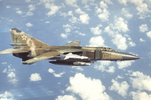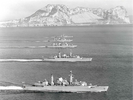Third Great War
The Third Great War, often abbreviated as GWIII or GW3, was a global war that lasted from 1976 to 1983, involving countries from all continents except Lohicamia. The Third Great War involved all of the world's major powers, united into two opposing alliances: the Third Coalition led by The Furbish Islands, Fluvannia, Greater Niagara, Alaoyi, Hrvada, and Chakotiyequa; and the Laurillac Pact led by Gagium, Gryva, Inglaterra, Dilania, Yawatha, Pätschlàn, Seocheon, and Alanna. The participants threw the whole of their economies, industries, and sciences into a total war that blurred the line between civilian and military targets. Strategic bombing, indiscriminate artillery and missile bombardment, and chemical weapons inflicted millions of civilian casualities. The Third Great War was the first global conflict that saw the widespread use of ballistic missiles to strike at targets thousands of kilometers away.
The Third Great War was the deadliest conflict in human history; it resulted in over TBD million fatalities between military and civilian deaths. Tens of millions were killed due to starvation, genocide, and disease. As a result, tribunals of war criminals were conducted against Gagian, Inglaterran, and Alannan leaders. Gagium, Gryva, Dilania, and parts of Alanna, Inglaterra, and the former León Monarchy were occupied by Third Coalition forces. Environmental destruction in parts of Alaoyi, Dilania, and Yawatha remained issues for decades.
The causes of the Third Great War are debated, but most historians agree that the unresolved conflict in the former León Monarchy, tensions between Alaoyi and Inglaerra, the ineffectiveness of the Forum and Council of Nations, proxy wars in the Gulf of Atily and former León Monarchy, and the rise of hardline communist governments in many countries contributed to causing the war. The Third Great War is considered to have started when two Alaoyian soldiers accidentally crossed the border with Inglaterra on March 2. The soldiers were shot and killed, angering Alaoyi. Both sides mobilized for war, and on March 12 Inglaterra and Dilania invaded Alaoyi, opening one of the largest land theaters of war in history. Gagium, Gryva, Pätschlàn, and Seocheon then declared war on the Third Coalition, which began the Stratean and western Abos fronts. The Coalition nations of Galia declared war on Gryva and the the Stratean powers in solidarity, though they would have little effect on those fronts.
In April 1976, Gagian aircraft attacked Furbish and Niagaran military bases in Stratea and the Tenific Ocean. Aircraft, ships, and submarines based in the Perlsienne attacked Furbish and Niagaran shipping. Laurillac Pact forces invaded Tresula, and Agnia, and pushed west from the latter. At around the same time, Gagium and Narulia began Operation Enduring Sunrise, bringing the conflict to the Gulf of Atily. Also in April, Gryva began invasions of Greater Niagara and Hrvada. The former was stalled in North Sol'Vin, and the front would move back and forth inside the country during the remainder of the war, while the latter resulted in a successful Hrvadan counterattack and slow push into Gryva. From early 1976 to mid 1977, Inglaterran, Alannan, Dilanian, and Yawathan troops advanced deep into Alaoyian territory. However, the winter of 1976 provided Alaoyian troops with time to build up their defenses in the Diash mountains. Following a series of failed attacks by Lauilliac Pact troops turned the tide of the conflict. These included the Battle of Merileach, which became one of the bloodiest battles in history.
In the Frigo and Galian fronts, the advantage turned towards the Coalition when a joint Furbish-Niagaran invasion captured Perlsienne, restricting the ability of Lauilliac Pact forces to attack shipping across the Tenific. Further naval defeats cost the Lauilliac Pact states their initiative and forced them into strategic retreat on some fronts by 1979, though they firmly held other fronts. By the start of 1979, Coalition troops had begun to advance into Inglaterran territory, and the bombing of key ports in southern Alanna meant that Alannan troops could not resupply their forces as easily. The Galian front turned towards Alanna when Inglaterra capitulated in 1981, and Coalition forces landed in Alanna in 1981. In late 1979, Fluvannia, Greater Niagara, and The Furbish Islands began Operation Cerecero in Serro, which became the largest naval invasion in history. In 1980, a rebellion in Gagium caused Coalition forces in the León Monarchy to invade Gagium, focusing attention away from Pätschlàn. The threat of Third Coalition invasion prompted Saint Sienia to withdraw support from the Lauilliac Pact following the attack on Gagium. Also in 1980, the tide of the western Abos front turned, and Gryva began to be invaded on both sides by Greater Niagara and Hrvada.
The war in Galia concluded with the final liberation of all captured Alaoyian territories and Coalition forces pushing into Inglaterra itself. After the capitulation of Inglaterra, Alaoyi and Naossia turned their attention towards Alanna with Operation King's Head. With the fall of Obodokohia and the overthrow of the Zurokist government, Alanna surrendered as well in October of 1982. Gryva was next to surrender in March 1983, ending all fighting in Abos. In Stratea, the push into Gagium successfully led to the collapse of the Lauilliac Pact alliance, with a final surrender document signed on 20 June 1983, but due to exhaustion on all sides, Pätschlàn was not invaded and lost relatively little.
The Third Great War changed the political alignment and social structure of Manala. The former Forum and Council of Nations was reformed into the Global Community, with the reforms intended to sponsor global cooperation and prevent any future great conflicts. The Furbish Islands and Niagara emerged as global superpowers. In the wake of the devastation, the Global Monetary Fund and International Bank were established to provide loans to rebuilding. Most countries whose industries had been damaged moved towards economic recovery and expansion. Political and economic integration, especially among the former Coalition states, began as an effort to forestall future hostilities and put an end to the tensions that had caused war on three occasions.







